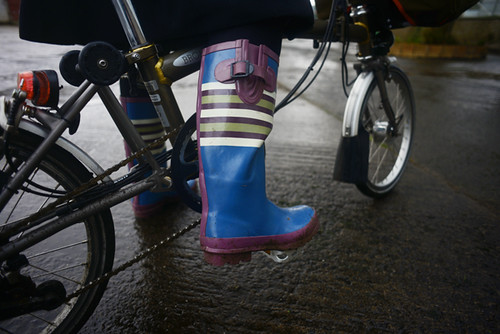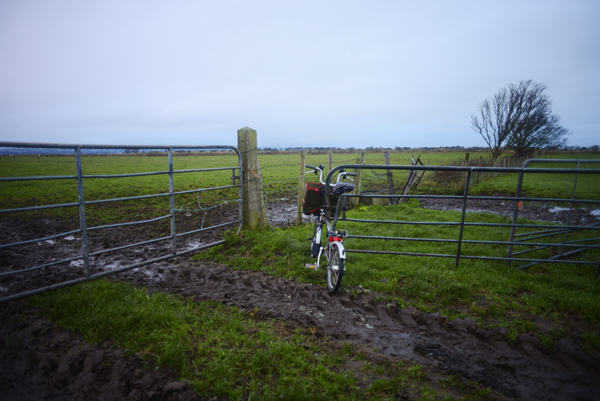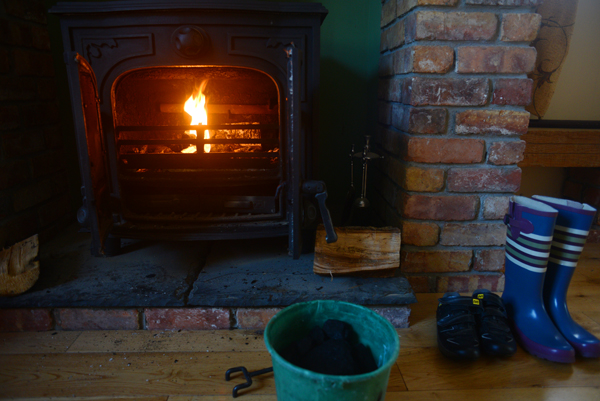Cycling in Wellies

Sure I harbored memories of their stiffness and lack of breathability from having donned them in the countryside years ago. But my resistance to Wellies went beyond that, most likely a result of their absurd, meteoritic rise to popularity in recent years. Step out into the urban streets of Cambridge, Massachusetts on a mildly drizzly day, and you'll encounter a rubber boot infestation out of all proportion to the amount of rain or the surface conditions at hand. Like flocks of exotically brightly-footed birds, crowds of young women in colourful Hunters and copies thereof stylishly stomp their way across shallow sidewalk puddles and the damp grasses of Harvard Yard. What's turned this awkward, uncomfortable form of footwear into a fashion accessory was beyond me. But for whatever reason Wellies seemed to have replaced UGGs and Crocks as the new Ugly It-Shoe, and I wasn't about to buy into the trend. Even when I found myself in circumstances where I actually needed the vile rubbery things for the original purpose they were designed for, I resisted - donning my normal, perfectly good waterproof boots instead.

But I did not resist for long. I live next to a farm now, and spend quite a bit of time there. The yard looks like this …on a dry-ish day.

Then there are the vast fields I cross to take photos along the water's edge. And while that green stuff may look like grass, the soil it grows on is soft and soggy. Seeing farm animals grazing with the fur on their legs wet and matted from sinking into the grass, it was clear that my normal, perfectly good waterproof boots would get destroyed after a couple of such forays. Not to speak of my interest in photographing abandoned peat bogs.

Anyway, Wellington boots. Nowadays you can buy all sorts of fancy versions, including those with a warm lining already built in. But considering the purposes I needed them for, I decided to go for the plain unlined type, meant to be worn with several pairs of socks. The rationale here is that should you step into deep water that goes over the edge of the boot, you just change your socks and can keep wearing the boots after wiping down the interior. With lined boots you would have to wait for the lining to dry if the interior gets wet.
Armed with the knowledge that I wanted plain rubber farmer's boots, I went to the local shops that sell such things. Sadly, it turned out my size 4UK feet are freakishly small by local farming standards. And so I walked out with a pair of teenage girls' boots in bright sky blue with green and lilac striped trim. So much for plain, but my other choices involved butterflies or pandas.

But of course looks aren't everything. So let's talk about what's important for us cyclists: power transfer. How are Wellies to cycle in? Well, kind of bad. The soles are quite flexible - somewhat more so than running shoes, but less so than foam flip-flops. Nothing about these boots said "I want to ride a bike in these!" the first time I wore them. But despite this, they are strangely addictive. The comfort of even the cheap ones I bought are a huge improvement upon the painfully uncomfortable, clammy Wellies I recall from childhood. The uppers are flexible and don't dig into my calves, the toes don't pinch even after an hour's hike through the peat bogs, and somehow my feet do not overheat despite their lack of breathability. In fact, worn over two or three pairs of wool socks, nothing keeps out the winter damp better.
Little by little I started to wear the Wellies not just on the farm or when walking across soggy fields, but out and about - including around town and on the bike. The flexible soles felt strange when pedaling at first, but I got used to it and have cycled in them for up to 14 miles so far with no adverse effects. An additional advantage, is that the Wellies' wide adjustable uppers fit easily over even the baggiest of trousers, keeping them safely tucked away from the bicycle's drivetrain. Of course they can be easily worn with a skirt as well. And when I come home covered knee-deep in mud - which seems to be the norm these days - I simply rinse the boots off and in seconds they are ready to wear again - the ultimate in low maintenance.

And so, my winter footwear wardrobe these days consists more or less of these. I've held myself back from going dancing in either of them so far, but I wouldn't rule it out.

One of my friends back in the Auld Sod is a big fan of mountain biking in wellies. Certainly, when there's lots of bog-trotting on the menu, it's wellies or a trip to the "hospital or infirmary." (Cue: Billy Connolly again)
ReplyDeleteAye, that boy apparently has lost his wellies. Ave you seen im lately?
DeleteAfter years of losing the battle with road salt and slush in leather boots (no matter how many kinds of waterproofing oils and pastes I applied, or how frequently), I have been living in Bean boots (aka duck boots--waterproofed-leather shaft, rubber from the ankle down). Like the wellies, they have very soft soles, but in the wet Chicago winter dry feet are a higher priority than optimal power transfer, at least for me. (I actually wore these boots on a 50-mile ride this weekend, and while I'm not sure I'd do that again, it certainly was nice to be able to keep my feet on the pedals while riding through several-inch-deep puddles of slush and water without worrying about spending the rest of the ride with freezing toes.)
ReplyDeleteI've been using Bogs Bridgeport shoes all the time in winter. They are made of rubber, fully waterproof and warm even in 0F weather (with double socks). They are only ankle-high and as such, they are not good in very deep snow, but at the same time are much more comfortable for cycling than full length Wellies.
ReplyDeleteGood to hear other people do the same! I wear my red wellies often on the bike. I have wide flat pedals, I think that helps. The farthest I've ridden was 60 miles. I had intended to replace my shoes once the rain cleared on the trail but it never happened.
ReplyDeletethought I'd share this picture a reader sent via twitter : )
ReplyDeleteI had something similar happen a few months ago helping my father sort cattle. I was doing a dead run across the cattle yard. Came across a squishy spot and my boots stayed put while I staggered a few steps bootless. Trouble was, what I was in wasn't mud.
DeleteSocks went in the garbage after that.
Ooooh my
DeleteFirst, I don't know why you call these awkward and uncomfortable!!, especially compared to some variety of shoes I see woman wearing, either on bicycles or while walking. They are actually quite comfortable and wonderfully practical and most families in our small town visit the farm co-op every year to outfit their growing kids with yet another pair and pass the old pair on down the line. Also, these are affordable compared to high maintenance and expensive leather boots. Anyway, many also use them while commuting and running errands on bicycles, myself included. I'm surprised you didn't see more in Boston, maybe it was the crowd you were with 'cause I know my son used his farm boots on the bike all through college while there. In the winter months some nice wool socks inside and everything is okie dokie, including shins. You've stumbled onto what others have known and embrace as part of the process of adapting and compromise.
ReplyDeleteI suspect there have been improvements in the design of these boots and perhaps also in the material they are made of over the years, because the ones I've worn in the past have honestly been torture devices!
DeleteYeah, you might be right though the years we went through this with the kids were the late eighties/early nineties and they don't seem to have evolved too much. Also, there are different brands. Mine are current pair are Tingley's (about six years old) and they're quite flexible and comfortable. When using them on a bike it's much better if one has a decent platform pedal.
DeleteTry riding your bike with circa 1972 motocross boots - hahahaha.
ReplyDeleteAny pair of shoes with enough room can accept a more walking/riding friendly, stiffer more supportive insole if so desired.
Those things should keep Mad Cow Disease at bay as long as you remove them with hand wellies.
"Try riding your bike with circa 1972 motocross boots"
DeleteThat could actually be arranged. Well maybe not in my size.
Any boot with enough room for three pairs of socks could easily accommodate a pair of 1972 bicycle shoes. Which are readily available in size 4.
DeleteThe Auld Sod, where function never goes out of style.
DeleteWhat, the local shops didn't have some plain teenage boys boots?
ReplyDeleteThey had boys' boots in tiny sizes, but not in my size.
DeleteIn the pacific northwest, you can either spend a fortune on water proof booties, allow your feet to get soaked, or go for rubber boots. I got a pair of hunters BEFORE the craze(always ahead of the trends for some reason!). I had wanted a pair for years, and suddenly they were popping up in stores. Unfortunately they were also being made in China instead of england! They were a gift, and I would not have bought them had I known they had sold their souls to cheap marketing. They are fine boots by the way, but a bit tight in the toes for me, too tight for thick socks as well. My previous wellies had distintigrated from wandering in the ocean, salt water destroys them, but I biked in those, and I bike in the hunters. No problem whatsoever, and since they are so high, they at least keep part of my legs dry! I have lambswool insoles which help a bit with the cold. My only problem is that if it is too cold, my feet freeze, so would want to invest in some wider and slightly bigger wellies in the future for extra wool socks.
ReplyDeleteI will admit, I have regularly cycled in Crocs in spite of their terribleness. I like to think their awful power transfer is made up for by the aerodynamics of having holes all throughout them. Or sometimes I just don't want to deal with putting on regular shoes. These boots, though... you may be on to something!
ReplyDeleteProbably some difference in price, but Le Chameau boots come with soles stiff enough to transfer a good deal of power to the pedal.
ReplyDeleteYeah, those are about 10x the price of the boots I bought : )
DeleteYour friends in the Northern Ireland Section of the Veteran Cycle Club would tell you that genuine traditional Irish wellies always had the letter ‘L’ moulded into the left sole and ‘R’ into the right sole. Even though your wellies are chic and modern, it would still be worth a look – Ireland is steeped in tradition, as you know, and old traditions die hard. ;)
ReplyDeleteThe interesting thing is that it *would* be somewhere like the VCC where I'd learn something like that. Most of old traditions here are no longer visible, as during the years of prosperity the younger generations (60s and under) seem to have put in great effort to shake off any aura of quaintness from rural life. So I hear stories, now based on vague memories, about how thing were, but seldom see remnants of it.
DeleteGrowing up around equines of all sorts I wore Muck brand boots. They have a good stiff sole (same issues in stirrups as on pedals) but they weigh a ton. While working at the donkey farm I invested in a pair of plain tall black Hunter brand wellies and added the insole from my Muck boots. That worked out really well! I didn't wear myself out stomping through the fields, and the insert added enough stiffness to the sole that they work fine for cycling. I was riding in them just today!
ReplyDeleteWellies, Gum Boots, Tingleys, Rubbers, everywhere I've lived there's been some generic name for them.
ReplyDeleteIn S. Texas when I was a kid they called em' "Rubbers" and they were only worn in public by the type that would pronounce the name with a leer and a wink. If you worked in the oilfield you had a couple of pairs in the back of the truck along with your smelly stripey coveralls and your 6 oz leather gloves with the 20 ounces of tar soaked into them. If you worked in Cattle you had a pair oversized enough to let you slip your Justin Ropers in and they probably lived under the seat of the truck with the sawed-off and a rolled up porno or two. If you worked on a Shrimp Boat they reeked of diesel and shrimp on the outside and worse on the inside.
It was jobs like that that drove me to emigrate to the 'States. I have a pair(cheap Chinese copies of Tingleys) I wear hauling wood in the mud and when I help a friend by walking through his poultry houses picking up the "croakers" when he's away("Bring out yer dead! Bring out yer dead!). They ARE nice and comfy in the snow with 2 pairs of wool socks. But the thing I like best about Wellies is that every time I pull on a pair I remember that I don't have to if I don't want to and that mine don't smell like diesel and shrimp anymore.
Spindizzy
On the West End of the Olympic Penninsula (Washington State) they call them Hoh River house slippers.
DeleteSounds like my kind of people...
DeleteSpinndizzy
P.S. The last word of my comment above should be deleted, Shrimper was the one job of the examples I gave that I never had to do. One looong, wretched day on my sisters first husbands shrimp boat was enough.
its a friday morning here, and a rabid one, i find the blog about the wellies - in therapy jargon, but nonetheles - "grounding", like cycling it makes me reconnect with just being alive in the moment, thanks for that
ReplyDeleteThose are cute! Not too girly and it sounds like theyre functional too. Who makes them?
ReplyDeleteSorry - there is no brand name that I can see, which is not unusual for cheap wellies sold here.
DeleteNancy Sinatra tells us that "these boots were made for walking" but Adapta,Improvise and Overcome also applies.
ReplyDeleteI cycled with wellies only once. Sadly, the lack of flexibility at the ankles of my made-for-fashion wellies made an already tiring uphill journey even more tiring, so I swore that I'd never do it again. Which is a shame, really, because they're the only shoes I own which are truly waterproof - could be perfect for the ever-wet roads in Edinburgh.
ReplyDelete